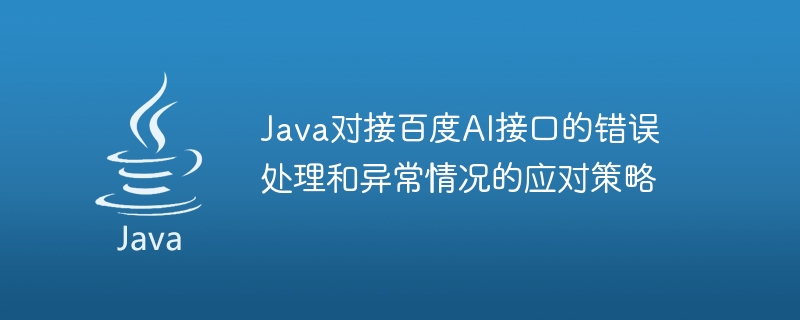

Error handling and exception response strategies for Java docking Baidu AI interface
When using Java to dock Baidu AI interface, we will inevitably face various errors and abnormal situations. These errors and exceptions may be caused by network connection problems, parameter transfer errors, authentication failures, etc. In order to ensure the stability and normal operation of the program, we need to implement appropriate handling and response strategies for these errors and exceptions. Next, we'll explore how to deal with these issues.
1. Network connection issues
When using the Baidu AI interface, due to the instability of the network connection, problems such as connection timeout and connection interruption may occur. To handle this situation, we can use the exception handling mechanism and retry mechanism in Java.
Exceptions are caught in Java by using try-catch statement blocks. When connecting to Baidu AI interface, we can handle network connection problems by catching IOException. When the exception is caught, we can choose to retry the connection or perform other error handling.
The sample code is as follows:
try {
// 调用百度AI接口的代码
} catch (IOException e) {
// 处理网络连接问题的代码
// 可以选择进行重试连接或进行其他的错误处理
}
When we capture a network connection exception, we can choose to retry the connection. Normally, we can use a loop to retry multiple times until the connection is successful or the maximum number of retries is reached.
The sample code is as follows:
int maxRetryTimes = 3; // 最大重试次数
int retryTimes = 0; // 当前重试次数
while (retryTimes < maxRetryTimes) {
try {
// 调用百度AI接口的代码
break; // 如果连接成功,则跳出循环
} catch (IOException e) {
// 处理网络连接问题的代码
// 可以选择进行其他的错误处理
retryTimes++; // 重试次数加一
}
}
2. Parameter passing error
When using the Baidu AI interface, we need to pass the correct parameters to make the interface work properly. If parameters are passed incorrectly, the interface call will fail or return incorrect results. In order to avoid this situation from happening, we need to perform parameter validity checking and error handling.
Before calling the Baidu AI interface, we need to check the legality of the incoming parameters. Legality check can include non-null judgment, type judgment and value range judgment of parameters, etc.
The sample code is as follows:
public void callBaiduAI(String param1, int param2) {
if (param1 == null || param1.isEmpty()) {
throw new IllegalArgumentException("param1不能为空");
}
if (param2 < 0 || param2 > 100) {
throw new IllegalArgumentException("param2应在0到100之间");
}
// 调用百度AI接口的代码
}
When an error in parameter transfer is found, we can choose to throw exceptions such as IllegalArgumentException, or return an error codes and error messages, etc. Different error handling strategies can be selected depending on the specific situation.
The sample code is as follows:
public void callBaiduAI(String param1, int param2) {
if (param1 == null || param1.isEmpty()) {
throw new IllegalArgumentException("param1不能为空");
}
if (param2 < 0 || param2 > 100) {
throw new IllegalArgumentException("param2应在0到100之间");
}
// 调用百度AI接口的代码
if (response.getCode() != 200) {
throw new RuntimeException("调用百度AI接口失败,错误码:" + response.getCode() + ",错误信息:" + response.getMessage());
}
}
3. Authentication failure
When using the Baidu AI interface, we need to perform authentication operations to obtain a valid Access Token. If authentication fails, the interface call will fail. In order to handle the situation of authentication failure, we can perform exception handling and re-authentication operations.
When an authentication failure exception is caught, we can choose to re-authenticate or perform other error handling.
The sample code is as follows:
try {
// 调用百度AI接口的代码
} catch (InvalidAccessTokenException e) {
// 处理鉴权失败的代码
// 可以选择重新鉴权或进行其他的错误处理
}
When we find that the authentication fails, we can choose to re-authenticate. The re-authentication operation can be implemented by re-obtaining the Access Token and updating it to the relevant request header information.
The sample code is as follows:
public void callBaiduAI() {
// 获取Access Token的代码
// 调用百度AI接口的代码
}
Summary
When Java interfaces with Baidu AI interface, we need to handle various errors and exceptions. For network connection problems, exception handling and retry mechanisms can be used to solve them; for parameter transfer errors, parameter validity checking and error handling can be performed; for authentication failures, exception handling and re-authentication operations can be performed. Reasonable error handling and response strategies can ensure the stability and normal operation of the program.
The above are the error handling and abnormal situation response strategies for connecting Java to Baidu AI interface. I hope it will be helpful to everyone.
The above is the detailed content of Error handling and abnormal situation response strategies for Java docking with Baidu AI interface. For more information, please follow other related articles on the PHP Chinese website!
